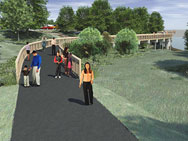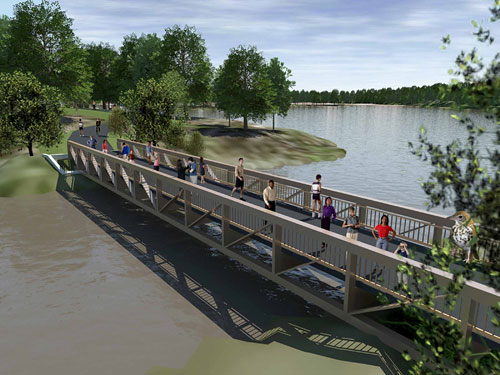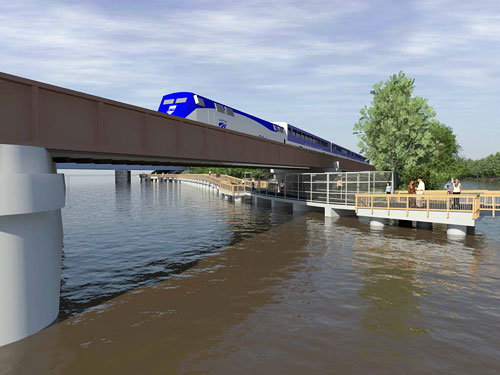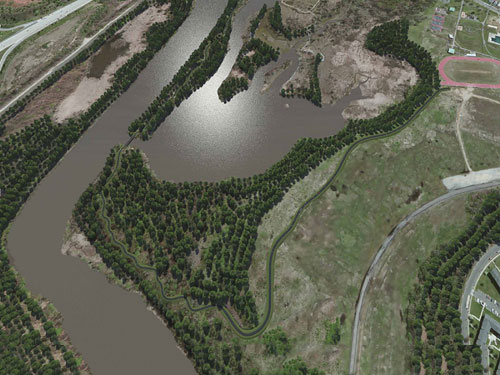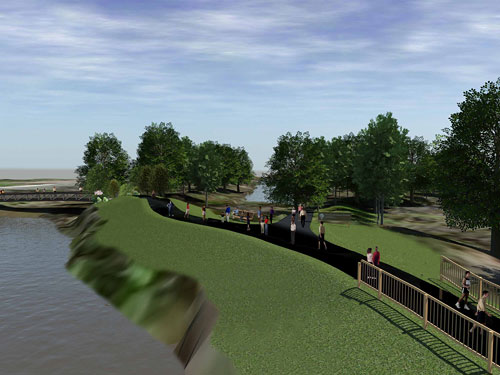Riverwalk will connect communities and the Anacostia River
Cyclists and runners, nature lovers, communities in DC’s Ward 7, residents of Prince George’s County, and the Anacostia River will all gain from the final segment of the Anacostia River trail network. An impressive lineup of elected officials and agency heads from DC and Prince George’s County gathered yesterday to unveil the segment’s design.
When completed in 2014, this trail alignment, segment 9 on the below map, will run from Benning Road north to the Maryland border. It will complete a crucial link between the District’s Anacostia Riverwalk Trail and Maryland’s Anacostia Tributary Trail system.
In April of this year, DDOT completed a bicycle and pedestrian bridge over the CSX tracks on the west side of the Anacostia River, which creates a seamless connection between M Street SE/11th Street SE and Benning Road NE. The bridge on the east side is scheduled to open the end of this year. It will close the missing link between Anacostia Park and Benning Road NE. Both appear on the map as segment 11.
Completing this trail network is exciting for a lot of different reasons.
It connects DC and Maryland, uniting our communities. Once complete, the Anacostia Riverwalk Trail will connect 16 different waterfront communities in DC and Maryland.
Not only will the continuous trail create recreation opportunities, but it creates a potential bike commuter route. For example, if a cyclist wants to bike from the Sousa Bridge (at Pennsylvania Ave SE) to the Bladensburg Waterfront today it would require a daunting excursion through local roads, including biking on Bladensburg Road.
It advances local and regional transportation goals. In anticipation of the transportation challenges that come with the DC region’s expected population and job growth, local and regional governments have developed aggressive goals to facilitate alternative modes of transportation. For example, the Region Forward Plan seeks to create a “transportation system that maximizes community connectivity and walkability, and minimizes ecological harm to the Region and world beyond.” Completing the ART system creates a safe environment for pedestrians and cyclists, which moves the Region Forward Plan closer to fruition.
It gives some Ward 7 neighborhoods access to parkland. As exciting as it is to think that people from all over the metro area will rediscover the Anacostia River, one of the best outcomes of this new trail segment is the access it will provide for the Ward 7 communities east of the river, but west of DC-295, to park lands and the river. (Note: the Kingman Park neighborhood of Ward 7 is west of the river).
Ironically, the National Park Service ownership along the Anacostia effectively “walls off” the river for communities like Mayfair Mansions and Kenilworth-Parkside. The new trail will provide new access routes into the park lands from the communities that surround them. Residents who have suffered living along a polluted Anacostia should certainly be among the first to reap the rewards of a clean river.
One challenge that still remains is connecting the remaining local communities east of 295 to the Anacostia Riverwalk Trail. Even once completed, 295 still cuts of access to the majority of residents living in Ward 7 and Ward 8.
It provides access to a beautiful section of the Anacostia River that is currently reachable only from the water. The biggest challenge facing the Anacostia River restoration is countering widely held beliefs that the river is a dirty place to avoid.
Make no mistake, there’s a lot of work left to be done before we have an Anacostia River that is safe for swimming and fishing. But even now it is a place of surprising beauty where people can walk, see wildlife, and seek solace in the heart of the city. This final trail segment will make these recreational uses possible in the most natural and hardest to access portion of the river.
Right now, at most a few hundred people enjoy this section of the river in any given year — rowers, kayakers, and others who can access the river by water. The new trail segment will take the number of people exposed to the beauty of the Anacostia River to tens of thousands yearly. More people that see and know the river means more people who care about its restoration.
The last several years have been unprecedented in terms of restoration progress, and we can consolidate and build on that momentum. We’ll need to if we are to reach DDOE’s goal of a swimmable and fishable river by 2032.

